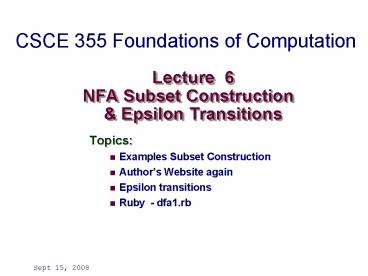Lecture 6 NFA Subset Construction - PowerPoint PPT Presentation
1 / 21
Title:
Lecture 6 NFA Subset Construction
Description:
Subset construction converting NFA equivalent DFA. TEST 1 September 29th ... 2.2.9 page 54 Prove If d(q0, a) = d(qf, a) for all a in S then for all w ! ... – PowerPoint PPT presentation
Number of Views:1015
Avg rating:3.0/5.0
Title: Lecture 6 NFA Subset Construction
1
Lecture 6NFA Subset Construction Epsilon
Transitions
CSCE 355 Foundations of Computation
- Topics
- Examples Subset Construction
- Authors Website again
- Epsilon transitions
- Ruby - dfa1.rb
Sept 15, 2008
2
- Last Time Readings 2.3
- HW Hints and Induction example
- Review
- Induction
- DFA for Union, revisit Example 2.4
- Pop Quiz
- Uses of Finite automata
- NFA
- Delta-hat, a string accepted by an NFA, the
language accepted - Subset construction converting NFA ? equivalent
DFA - TEST 1 September 29th
- New Readings section 2.2.3-2.4
- Examples Subset construction converting NFA?
equivalent DFA - Authors Website Solutions Online
3
NFA example Figure 2.9
- x
- What does the ?p mean?
- What does the r mean?
- What is d(s, x) informally?
- Page 56
- Transition Table (NFA)
0
1
p
q
r
0,1
4
Subset Construction example Figure 2.9
- Page 56 of text
0
1
p
q
r
Equivalent DFA Table
0,1
5
Subset Construction example Figure 2.9
- Page 56 of text
0
1
p
q
r
Equivalent DFA Table
0,1
6
Subset Construction Significance
- Constructing an equivalent DFA from and NFA
- What does equivalent mean?
- Does equivalent mean have the same number of
states? - Equivalent means ?
- Why convert?
- What is better about an NFA?
- What is better about a DFA?
- We are interested in the power of these models?
- Can an NFA recognize a language that a DFA cant?
- Can a DFA recognize a language that an NFA cant?
7
Exercise 2.2.9 Solutions Online
- Authors Website for Text
- http//infolab.stanford.edu/ullman/ialc.html
- HW Solutions for starred () problems
- http//infolab.stanford.edu/ullman/ialcsols/sol2.
html - 2.2.9 page 54 Prove If d(q0, a) d(qf, a) for
all a in S then for all w ! e we have d(q0, w)
d(qf, w) by induction on the length of w. - Basis
- Assume
- Then we need to show that
- Dr. Ullmans (Jeffs) slides from CS 154
- http//infolab.stanford.edu/ullman/ialc/jdu-slide
s.html
8
Homework and Test 1
- HW 2
- Extra Credit
- http//infolab.stanford.edu/ullman/ialc/slides/sl
ides1.pdf - HW 3
- 4a
- 4b
- 5
- 6
- HW 4
- Pop Quiz
9
Subset Example from Authors website slides2.pdf
10
Mutual Induction Proof
- Write up on back of Lecture Overview
11
Consider our old friend from HW 2.2.5bL w e
0,1 the tenth symbol from the right end of w
is a 1
0,1
0,1
0,1
1
0,1
10
3
4
0
1
2
0,1
- If we convert an NFA with n states to a DFA using
the subset construction what is the max number
states in the DFA? - Can we do better?
- Subset construction an example of lazy
evaluation i.e. consider only states we can
get to from q0 - DFA minimization is a topic for later
12
Ruby Strings and DFAs (dfa1.rb)
- DFA1.rb on Handouts page
- Now consider how to generate all strings in S
of length 6 - Idea generate them from a list of the strings
of length n-1 - by concatenating onto each string w of length
n-1 each a e S (a recursive definition) - lists of strings of length n-1 and n
- strnm1 Array.new()
- strn Array.new()
- strnm1 "a", "b"
- print "strnm1 strnm1\n
13
- 2,3,4,5, 6, 7, 8.each len
- numstrings 0
- strnm1.each str
- alphabet.each chr
- x chr str
- strnnumstrings x
- numstrings numstrings 1
- print "Strings of length len\n"
- strn.each str print "str\n"
- strnm1 strn
- strn Array.new
- numstrings 0
14
Theorem 2.11 For NFA there is Eq. DFA
15
Theorem 2.12 L is accepted by DFA if and only if
L is accepted by NFA
16
Epsilon (e)-Transitions
- Keyword Searching Example for, format, font
17
(No Transcript)
18
(No Transcript)
19
Epsilon Closure
20
Equivalent NFA (without e) for an NFA with e
- Convert NFA with e to an equivalent NFA without e
- Compute transitive closure of e arcs
- If p can reach state q by e arcs and d(r, a)
contains p (there is a transition from r to q on
input a) then add q to d(r, a) i.e. add a
transition from r to q on input a - xx
21
References and Homework
- Ruby pickaxe book Online
- http//whytheluckystiff.net/ruby/pickaxe/
- Authors Website for Text
- http//infolab.stanford.edu/ullman/ialc.html
- Slides, HW, Exams































